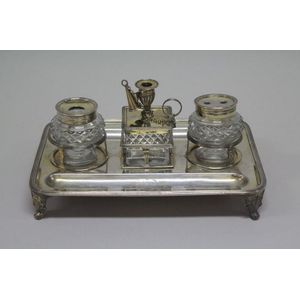George III Silver Ink Stand with Glass Bottles and Taper Stick
You must be a subscriber, and be logged in to view price and dealer details.
Subscribe Now to view actual auction price for this item
When you subscribe, you have the option of setting the currency in which to display prices to $Au, $US, $NZ or Stg.
- Sterling Silver - Sterling silver is a mixture of 92.5% pure silver and 7.5% of another metal, usually copper. Fine silver is 99.9% pure silver, and is relatively soft and the addition of the very small amount of copper gives the metal enough strength and hardness to be worked into jewellery, decorative and household objects.
- George Iii - George III (1738 - 1820) was King of Great Britain and Ireland from 1760 to 1820.
- Fire Gilding - Fire gilding is a process used in metalworking in which an amalgam of mercury and gold is applied to an object and then exposed to heat to vaporize the mercury and leave the gold behind in a thin layer. Fire gilding also is applicable to plating silver, copper, and copper alloys.
- Gilding - Gilding is a method of ornamentation whereby a thin sheet of gold metal is applied to items made of wood, leather, ceramics, glass and silver for decorative purposes.
For furniture including mirrors, the sheet of gold is usually applied over a coating of gesso. Gesso is a mixture of plaster of Paris and gypsum mixed with water and then applied to the carved wooden frames of mirrors and picture frames as a base for applying the gold leaf. After numerous coats of gesso have been applied, allowed to dry and then sanded a coat of "bole", a usually red coloured mixture of clay and glue is brushed on and allowed to dry, after which the gold leaf is applied. Over time parts of the gilding will rub off so the base colour can be seen. In water gilding, this was generally a blue colour, while in oil gilding, the under layer was often yellow. In Victorian times, gilders frequently used red as a pigment beneath the gold leaf.
Metal was often gilded by a process known as fire gilding. Gold mixed with mercury was applied and heated, causing the mercury to evaporate, the long-term effect of which was to kill or disable the craftsman or woman from mercury poisoning. The pursuit of beauty has claimed many victims, not the least of which were the artists who made those pieces so highly sought after today.
This item has been included into following indexes:
- ink stands - silver items 130
-
ink wells / ink stands, material
- glass objects 229
- silver items 303
- ink wells / ink stands, period or age - George III / Georgian 27
Visually similar items

Antique French glass and metal ink stand, approx 16.5 cm wide

A heavy sterling silver table Inkstand with rectangular tray and two lidded ink pots with sand shaker between. Original glass liners. Chrichton Bros. London 1919. Weight 1208g. Width 24.5 cm. Depth 18.5 cm

Antique French glass and metal ink stand, approx 16.5 cm wide

Pair 19th century French opera glasses painted with classical romantic landscape views, black enamelled
